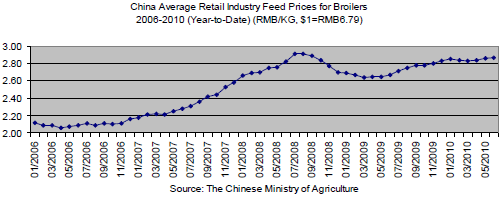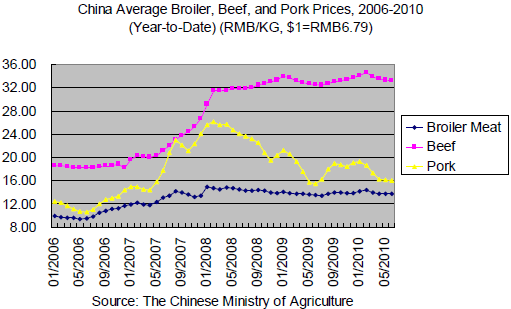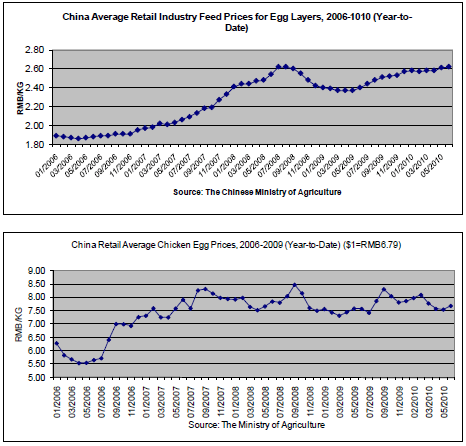



China - Poultry and Products Annual 2010
Chicken meat output in China is forecast to increase a further four per cent in 2011, write Michael Woolsey and Jianping Zhang in the latest GAIN Report from the USDA Foreign Agricultural Service.Highlights
FAS Beijing forecasts China’s broiler meat production in 2011 will continue modest growth, rising nearly four per cent to 13 million metric tons (MMT). Meanwhile, China’s broiler meat imports will decline 18 per cent following a 22 per cent decline in 2010 due to anti-dumping duties placed on US chicken. China’s broiler meat exports will continue to rise in 2011, fueled by strong demand in Japan and Hong Kong.
Executive Summary
FAS Beijing (Post) forecasts China’s poultry meat production will continue modest gains in 2011, up four per cent to 13 million metric tons (MMT). Rising broiler meat prices in the second half of 2010 are more than offsetting still high feed costs and will encourage continued strong production into 2011. China’s broiler meat imports in 2011 will decline 14 per cent to 280,000 metric tons (MT), following a 22 per cent decline in 2010. Higher imports from Brazil and Argentina have not completely replaced sharply lower imports from the United States. 2010 Chinese broiler meat imports from the United States (including claws) have fallen more than 80 per cent (through July), due to anti-dumping and counter-vailing duties imposed on US poultry in mid-February. These duties will continue into 2011 as a result of MOFCOM’s recent final determinations in their anti-dumping and counter-vailing duty investigations.
Post forecasts China’s broiler meat exports in 2011 will increase nearly eight per cent to 410,000 metric tons (MT), following strong sales in 2010. Consumer demand in Japan and Hong Kong has been particularly brisk in 2010, and industry contacts are expecting continued strong sales in 2011.
Broiler Production Forecast to Rise Four Per Cent in 2011
Chinese broiler output is expected to reach 13 million metric tons, following a four per cent increase in 2010. Strong demand for local chicken is offsetting continued high feed costs and encouraging producers to expand placements. Reduced imports from the United States following the implementation of anti-dumping duties in February 2010 are also helping to boost local prices. Wholesale broiler prices in September 2010 topped 13 yuan ($1.93) per kilo, well above prices at the same time in 2009 and 2008.
An expected, large inventory of grandparent (GP) generation breeding broilers will pave the way for steady growth in commercial bird production in 2011. Chinese industry contacts expect China’s imports of GP breeding broilers in 2010 will hit a record one million sets (1 set=120 birds), with especially strong sales expected in the last quarter of 2010 to prepare for higher expected output in 2011. These imports in the previous two years were 800,000 and 960,000 sets, respectively.
Reduced outbreaks of highly pathogenic avian influenza (HPAI) in 2010 are another factor helping the Chinese broiler industry maintain steady production growth. Lower rates of reported disease are partly due to China’s continued shift toward larger-sized and more standardised commercial production. While a ‘company plus contracted household farm’ model for large-scale companies has predominated to date, there is a gradual shift toward a ‘company plus production base (company’s own farms) plus contracted household farms’ for broiler supplies.
Meanwhile, minimum volumes for contracted household farms are also reportedly rising, in some cases to more than 5,000 birds per delivery. Previously, household farms could obtain contracts with only 2,000 birds per delivery. This has encouraged small operators to improve their production capacity and facilities. Zhucheng Foreign Trade Company, one of China’s top ten broiler companies in Shandong province, has reduced its contracts with household farms from one-third of total volume to 17 per cent over the last couple of years.

While better economies of scale and integration are improving competitiveness, Chinese operators continue to be challenged by high feed costs, which continued to climb in 2010. Prices for corn, which accounts for 55 to 60 per cent of broiler feed, from January through June jumped 25 per cent from the same period the year before to RMB1,970 ($291) per metric ton (MT). Overall, broiler feed prices in 2010 have risen to RMB 2,887 ($423) per metric ton through June, up seven per cent from the same six-month period last year.
Broiler Consumption Forecast to Rise 3 Per Cent in 2010

Post forecasts China’s total broiler meat consumption in 2011 will rise three per cent to nearly 13.3MMT (not including claws), following a two per cent increase in the previous year. This will boost Chinese per-capita broiler consumption to a record 10kg.
Continued demand gains are bolstered by the low cost of broiler meat compared to pork and beef. The efficient feed-gain ratio for broilers reduces production costs and helps keep chicken prices low. Chicken claws, wings and legs account for the vast majority of Chinese retail chicken sales.
Broiler Product Imports in 2011 Forecast to Decline 14 Per Cent
Post forecasts China’s broiler meat imports in 2011 will decrease 14 per cent to 280,000MT following an estimated 22 per cent decrease in the previous year, excluding chicken claws.
2010 Chinese broiler meat imports from the United States (including claws) have fallen more than 80 per cent (through July) due to anti-dumping and counter-vailing duties imposed on US poultry in mid-February. These duties will continue into 2011 as a result of MOFCOM’s recent final determinations in their anti-dumping and counter-vailing duty investigations.
Higher imports from Brazil and Argentina have not completely replaced the sharply lower imports from the US due to capacity limitations on South American product. Argentina cannot supply significant volumes of mid-wings, a key import item in China. In addition, traders are reporting that quality is sometimes uneven compared to other suppliers. The Automated Registration Form (import licence) is another limitation since maximum volumes per licence are based partly on previous year’s imports.
China’s chicken claw imports account for 50 to 60 per cent of the country’s total poultry imports. Before implementation of anti-dumping and countervailing duties, the US was the largest supplier by far. Limited volumes of US claw shipments will continue despite the AD and CV duties as some exporters will cut export prices since there are no alternative markets for this cut.
China Issues Final AD and CVD Determination against US Broiler Products
On 26 September, the Ministry of Commerce (MOFCOM) published the final determination in its antidumping (AD) investigation against US chicken products. The determination goes into effect on 27 September. These duties are in addition to final counter-vailing duties announced in August.
The table below shows the final AD margins, along with the preliminary margins introduced in February.

On 29 August, China's Ministry of Commerce (MOFCOM) announced its counter-veiling duty (CVD) final determination. The final CVD margins vary from four to 30.3 per cent and became effective on 30 August.

Broiler Exports in 2011 Forecast to Increase Eight Per Cent
Post forecasts China’s broiler exports in 2011 will increase nearly eight per cent to 410,000MT, following an estimated 31 per cent increase in 2010. Exporters are reporting robust growth in nearly all of China’s key markets, with Japan and Hong Kong continuing to lead sales accounting for nearly 70 per cent of the total combined.
Sales to Japan are bolstered by an improving economy compared to the same period last year and shippers expect continued strong sales in 2011. In Hong Kong, mainland China chicken cut imports are rising along with overall sales of fresh/chilled chicken. Environmental concerns are reducing sales of live broilers and encouraging a shift to fresh/chilled cuts, a trend that will continue to support sales to Hong Kong in 2011.
Eggs
Poultry Egg Production to Rise Two Per Cent in 2011
Post forecasts China’s total poultry egg production in 2011 will increase over two per cent to 27.7MMT following a two per cent increase in 2010. Higher production is partly due to improved control of avian leukosis virus (J-ALV), which hindered production in 2009.


China’s monthly poultry egg price in June 2010 declined five per cent to RMB7.68 ($1.13) per kilo from February due to oversupply. China Animal Husbandry Association monitoring shows that China’s total grand-parent (GP) generation breeding layer inventory is 569,000 sets with imported GPG breeding layers accounting for 57 per cent at 321,600 birds. The remaining 247,700 sets are domestic GP breeders. Industry contacts consider that continued development of the domestic GPG breeding industry is a key factor behind the current oversupply of parent generation (PG) breeding layers and commercial egg layers. Yukou, the largest domestic GP breeding layer company, alone could have 200,000 sets of GPG breeding layers ready for reproduction.
Further Reading
| - | You can view the full report by clicking here. |
October 2010








